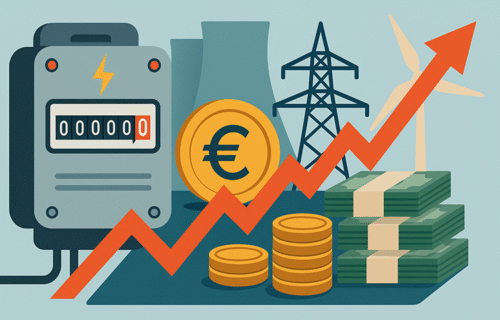Poland continues to record some of the highest electricity costs in the EU when adjusted for purchasing power, according to the latest Eurostat dataset for the first half of 2025. Prices for households rose by around 20% year-on-year, placing Poland among the fastest-growing electricity markets in the bloc. When expressed in PPS terms, Poland ranked second-highest in the EU—just behind Czechia and followed closely by Italy.
Industry analysts note that the issue extends beyond the price of energy itself. Polish consumers pay for a wide range of regulated surcharges that together make up a substantial portion of their final bills. These include the capacity fee, renewable energy (OZE) fee, cogeneration fee, transition fee, steadily rising distribution charges, and full VAT. While each component supports part of the national energy system, they also act as quasi-fiscal instruments, increasing household burdens regardless of wholesale price movements.
Recent regulatory developments suggest that these charges will rise further in 2026. Draft regulations published by the energy ministry indicate that the cogeneration fee will increase from PLN 3.00/MWh to PLN 4.36/MWh—a rise of roughly 45%. At the same time, the Energy Regulatory Office (URE) has approved substantial increases in the capacity fee for 2026, with analysts describing the adjustment as one of the steepest seen since the mechanism was introduced. Other regulated surcharges, including elements of the RES-support system, are also expected to increase next year based on preliminary regulatory signals.
Against this backdrop, President Karol Nawrocki has put forward a high-profile legislative package titled “Tani Prąd –33%” (Cheap Electricity –33%), which aims to reduce electricity bills for household and small-business customers. The bill, submitted to parliament, is structured around four pillars:
Elimination of selected fees – the capacity fee, RES fee, cogeneration fee and the transitional fee.
Reform of the certificates-of-origin system, reducing the cost burden placed on consumers.
Lower distribution fees, achieved by reducing the allowed rate of return for grid operators.
A VAT cut on electricity from 23% back to 5%.
According to the President’s Office, the reductions would be financed largely through revenues from the EU Emissions Trading System (ETS), which currently contribute several billion zloty annually to the state budget. Independent commentators, however, note that the reform could absorb a significant portion of these funds, raising questions about available financing for network upgrades, renewable capacity, and Poland’s upcoming nuclear investments.
A broader concern among market observers is that reducing regulated returns for distribution operators may limit their ability or incentive to invest in grid modernisation. With electrification accelerating and renewable capacity expanding, delays in upgrading lines, transformers and system flexibility could ultimately increase long-term costs.
Yet the proposal has brought clarity to one central point: high Polish electricity bills stem less from raw energy prices and more from layers of regulated charges built up over many years. The President’s initiative acknowledges this structure directly and places political emphasis on reducing the non-market components of electricity pricing.
Whether the programme becomes law—and whether its financing model proves sustainable—remains to be seen. For now, the debate underscores a structural challenge within Poland’s energy economy: balancing affordability, investment needs and stability in a sector undergoing rapid transformation.
Source: WEI
